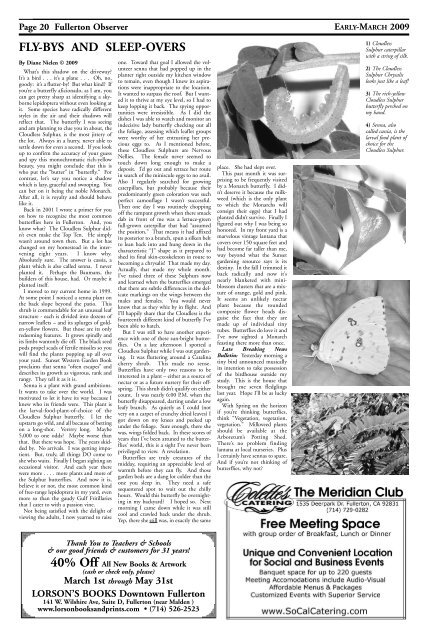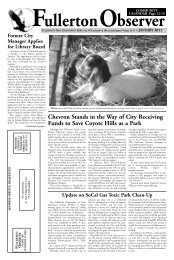Download - Fullerton Observer
Download - Fullerton Observer
Download - Fullerton Observer
You also want an ePaper? Increase the reach of your titles
YUMPU automatically turns print PDFs into web optimized ePapers that Google loves.
Page 20 <strong>Fullerton</strong> <strong>Observer</strong> EARLY-MARCH 2009<br />
FLY-BYS AND SLEEP-OVERS<br />
By Diane Nielen © 2009<br />
What’s this shadow on the driveway?<br />
It’s a bird . . . it’s a plane . . . Oh, no,<br />
goody: it’s a flutter-by! But what kind? If<br />
you’re a butterfly aficionado, as I am, you<br />
can get pretty sharp at identifying a skyborne<br />
lepidoptera without even looking at<br />
it. Some species have radically different<br />
styles in the air and their shadows will<br />
reflect that. The butterfly I was seeing<br />
and am planning to clue you in about, the<br />
Cloudless Sulphur, is the most jittery of<br />
the lot. Always in a hurry, never able to<br />
settle down for even a second. If you look<br />
up to confirm the accuracy of your guess<br />
and spy this monochromatic rich-yellow<br />
beauty, you might conclude that this is<br />
who put the “butter” in “butterfly.” For<br />
contrast, let’s say you notice a shadow<br />
which is lazy, graceful and swooping. You<br />
can bet on it being the noble Monarch.<br />
After all, it is royalty and should behave<br />
like it.<br />
Back in 2001 I wrote a primer for you<br />
on how to recognize the most common<br />
butterflies here in <strong>Fullerton</strong>. And, you<br />
know what? The Cloudless Sulphur didn’t<br />
even make the Top Ten. He simply<br />
wasn’t around town then. But a lot has<br />
changed on my homestead in the intervening<br />
eight years. I know why.<br />
Absolutely sure. The answer is cassia, a<br />
plant which is also called senna. I never<br />
planted it. Perhaps the Baumans, the<br />
builders of this house, had. Or maybe it<br />
planted itself.<br />
I moved to my current home in 1999.<br />
At some point I noticed a senna plant on<br />
the back slope beyond the patio. This<br />
shrub is commendable for an unusual leaf<br />
structure - each is divided into dozens of<br />
narrow leaflets – and its splurges of golden-yellow<br />
flowers. But those are its only<br />
redeeming features. It grows spindly and<br />
its limbs wantonly die off. The black seed<br />
pods propel scads of fertile missiles so you<br />
will find the plants popping up all over<br />
your yard. Sunset Western Garden Book<br />
proclaims that senna “often escapes” and<br />
describes its growth as vigorous, rank and<br />
rangy. They tell it as it is.<br />
Senna is a plant with grand ambitions.<br />
It wants to take over the world. I was<br />
motivated to let it have its way because I<br />
knew who its friends were. This plant is<br />
the larval-food-plant-of-choice of the<br />
Cloudless Sulphur butterfly. I let the<br />
upstarts go wild, and all because of betting<br />
on a long-shot. Verrrry long. Maybe<br />
5,000 to one odds? Maybe worse than<br />
that. But there was hope. The years skidded<br />
by. No arrivals. I was getting impatient.<br />
But, truly, all things DO come to<br />
she who waits. Finally I began sighting an<br />
occasional visitor. And each year there<br />
were more . . . . more plants and more of<br />
the Sulphur butterflies. And now it is,<br />
believe it or not, the most common kind<br />
of free-range lepidoptera in my yard, even<br />
more so than the gaudy Gulf Fritillaries<br />
that I cater to with a passion vine.<br />
Not being satisfied with the delight of<br />
viewing the adults, I now yearned to raise<br />
one. Toward that goal I allowed the volunteer<br />
senna that had popped up in the<br />
planter right outside my kitchen window<br />
to remain, even though I knew its aspirations<br />
were inappropriate to the location.<br />
It wanted to surpass the roof. But I wanted<br />
it to thrive at my eye level, so I had to<br />
keep lopping it back. The spying opportunities<br />
were irresistible. As I did the<br />
dishes I was able to watch and monitor an<br />
indecisive lady butterfly checking out all<br />
the foliage, assessing which leaflet groups<br />
were worthy of her entrusting her precious<br />
eggs to. As I mentioned before,<br />
these Cloudless Sulphurs are Nervous<br />
Nellies. The female never seemed to<br />
touch down long enough to make a<br />
deposit. I’d go out and retrace her route<br />
in search of the miniscule eggs to no avail.<br />
Also I regularly searched for growing<br />
caterpillars, but probably because their<br />
predominantly green coloration was such<br />
perfect camouflage I wasn’t successful.<br />
Then one day I was routinely chopping<br />
off the rampant growth when there smack<br />
dab in front of me was a lettuce-green<br />
full-grown caterpillar that had “assumed<br />
the position.” That means it had affixed<br />
its posterior to a branch, spun a silken belt<br />
to lean back into and hung down in the<br />
characteristic “J” shape as it prepared to<br />
shed its final skin-exoskeleton in route to<br />
becoming a chrysalis! That made my day.<br />
Actually, that made my whole month.<br />
I’ve raised three of these Sulphurs now<br />
and learned when the butterflies emerged<br />
that there are subtle differences in the delicate<br />
markings on the wings between the<br />
males and females. You would never<br />
know that as they whiz by in flight. And<br />
I’ll happily share that the Cloudless is the<br />
fourteenth different kind of butterfly I’ve<br />
been able to hatch.<br />
But I was still to have another experience<br />
with one of these sun-bright butterflies.<br />
On a late afternoon I spotted a<br />
Cloudless Sulphur while I was out gardening.<br />
It was fluttering around a Catalina<br />
cherry shrub. This made no sense.<br />
Butterflies have only two reasons to be<br />
interested in a plant – either as a source of<br />
nectar or as a future nursery for their offspring.<br />
This shrub didn’t qualify on either<br />
count. It was nearly 6:00 P.M. when the<br />
butterfly disappeared, darting under a low<br />
leafy branch. As quietly as I could (not<br />
very on a carpet of crunchy dried leaves) I<br />
got down on my knees and peeked up<br />
under the foliage. Sure enough, there she<br />
was, wings folded back. In these scores of<br />
years that I’ve been attuned to the butterflies’<br />
world, this is a sight I’ve never been<br />
privileged to view. A revelation.<br />
Butterflies are truly creatures of the<br />
midday, requiring an appreciable level of<br />
warmth before they can fly. And those<br />
garden beds are a dang lot colder than the<br />
one you sleep in. They need a safe<br />
sequestered spot to wait out the chilly<br />
hours. Would this butterfly be overnighting<br />
in my backyard? I hoped so. Next<br />
morning I came down while it was still<br />
cool and crawled back under the shrub.<br />
Yep, there she still was, in exactly the same<br />
Thank You to Teachers & Schools<br />
& our good friends & customers for 31 years!<br />
40% Off All New Books & Artwork<br />
(cash or check only, please)<br />
March 1st through May 31st<br />
LORSON’S BOOKS Downtown <strong>Fullerton</strong><br />
141 W. Wilshire Ave, Suite D, <strong>Fullerton</strong> (near Malden )<br />
www.lorsonbooksandprints.com • (714) 526-2523<br />
place. She had slept over.<br />
This past month it was surprising<br />
to be frequently visited<br />
by a Monarch butterfly. I didn’t<br />
deserve it because the milkweed<br />
(which is the only plant<br />
to which the Monarchs will<br />
consign their eggs) that I had<br />
planted didn’t survive. Finally I<br />
figured out why I was being so<br />
honored. In my front yard is a<br />
marvelous vintage lantana that<br />
covers over 150 square feet and<br />
had become far taller than me,<br />
way beyond what the Sunset<br />
gardening resource says is its<br />
destiny. In the fall I trimmed it<br />
back radically and now it’s<br />
nearly blanketed with miniblossom<br />
clusters that are a mixture<br />
of orange, gold and pink.<br />
It seems an unlikely nectar<br />
plant because the rounded<br />
composite flower heads disguise<br />
the fact that they are<br />
made up of individual tiny<br />
tubes. Butterflies do love it and<br />
I’ve now sighted a Monarch<br />
feasting there more than once.<br />
Late Breaking News<br />
Bulletin: Yesterday morning a<br />
tiny bird announced musically<br />
its intention to take possession<br />
of the birdhouse outside my<br />
study. This is the house that<br />
brought me seven fledglings<br />
last year. Hope I’ll be as lucky<br />
again.<br />
With Spring on the horizon<br />
if you’re thinking butterflies,<br />
think “Vegetation, vegetation,<br />
vegetation.” Milkweed plants<br />
should be available at the<br />
Arboretum’s Potting Shed.<br />
There’s no problem finding<br />
lantana at local nurseries. Plus<br />
I certainly have sennas to spare.<br />
And if you’re not thinking of<br />
butterflies, why not?<br />
1) Cloudless<br />
Sulphur caterpillar<br />
with a string of silk.<br />
2) The Cloudless<br />
Sulphur Chrysalis<br />
looks just like a leaf!<br />
3) The rich-yellow<br />
Cloudless Sulphur<br />
butterfly perched on<br />
my hand.<br />
4) Senna, also<br />
called cassia, is the<br />
larval food plant of<br />
choice for the<br />
Cloudless Sulphur.

















